Students looking for the Bridges in Mathematics Grade 5 Student Book Answer Key Unit 8 Module 2 can find a better approach to solve the problems.
Bridges in Mathematics Grade 5 Student Book Answer Key Unit 8 Module 2
Bridges in Mathematics Grade 5 Student Book Unit 8 Module 2 Session 1 Answer Key
Earth Materials
Question 1.
What do you predict will happen to the temperature of earth materials when you place cups of four different earth materials in the sun and then move them to the shade? Explain your reasoning.
Answer:
Students predict the temperature of Earth materials,
Explanation:
Students will be able to predict and explain their areas such that suppose if they place cups of four different earth materials such as sand , soil , water and rock will place in sun then if they move to shade the temperature of earth materials will be measure the temperature should be limited to relative measure such as warmer or cooler . And they make observations of color , size , temperature of four cups.
Question 2.
Follow these directions to test your prediction.
- Each team member choose a different earth material to test—dry soil, wet soil, water, or rocks.
- Get a plastic cup and mark a line on the cup 2 inches from the bottom with a marking pen.
- Place a thermometer in the cup and then carefully fill your cup to the line with the material you chose. If you are testing wet soil, pour 4 cup water into the cup, add the dry soil to the line, and stir before adding the thermometer.
Answer:
Following these directions to test my predictions, each team member chooses a different earth material to test—dry soil, wet soil, water, or rocks. Get a plastic cup and mark a line on the cup 2 inches from the bottom with a marking pen. Place a thermometer in the cup and then carefully fill your cup to the line with the material you chose. If we are testing wet soil, pour 4 cup water into the cup, add the dry soil to the line, and stir before adding the thermometer,
Question 3.
When you go outside, place the cups close together, but do not let them cast a shadow on each other. In the table on the next page, record the starting time and temperature of all of your team’s cups. Then return inside to start creating a temperature/time graph.
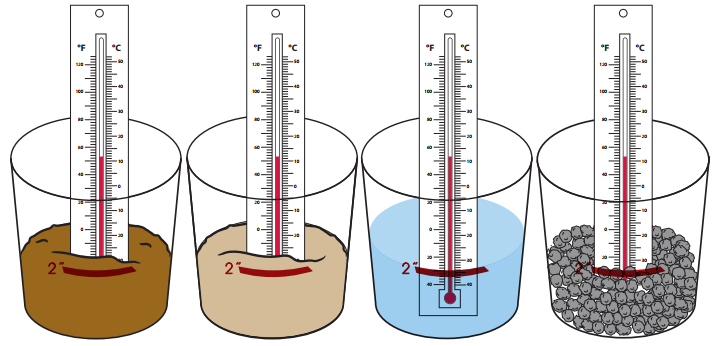
Answer:
52° F , 52° F, 52° F, 52° F,
Explanation:
When I go outside placed the cups close together, but do not let them cast a shadow on each other. Record the starting time and temperature of all of my team’s cups. Then returning inside to start creating a temperature as 52° F , 52° F, 52° F, 52° F.
Question 4.
Return outside in 20 minutes and record the temperature of your earth material. Then transfer the cup to the shade, take another temperature reading, and record it in the table.
Answer:
53° F , 53° F, 53° F, 53° F,
Explanation:
Returning outside in 20 minutes and recording the temperature of my earth material. Then transferred the cup to the shade taking another temperature reading and recording above as
53° F , 53° F, 53° F, 53° F.
Question 5.
Take a temperature reading every three minutes in the shade and record it in the table. While you are waiting, record the temperatures of all of your team’s earth materials.

Answer:
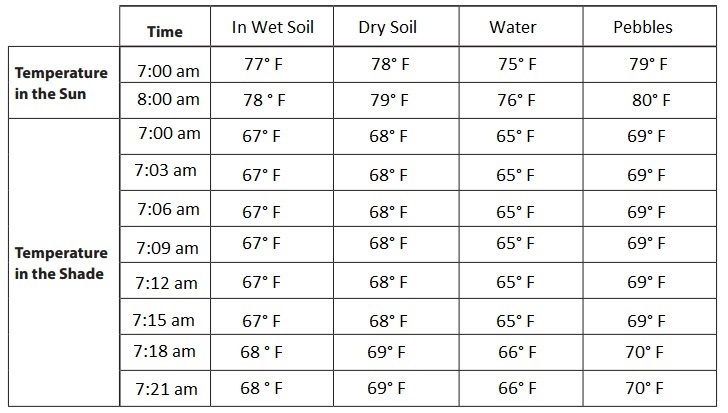
Explanation:
Recorded the temperature of every three minutes in shade of earth materials.
Question 6.
What do you notice about the temperature of the earth materials as they sit in the shade?
Answer:
In shade the temperature of the earth materials reduced from 79° F to 70° F,
Explanation:
I noticed in shaded region the temperature of the earth materials has reduced from 79° F in the sun to 70° F.
Earth Materials in Boxes
The students in Ms. Vega’s class wanted to use boxes without lids instead of cups to test how earth materials collect and store solar energy. They decided to build all the different boxes with a volume of 96 cubic centimeters.
Question 1.
What are the dimensions of all the boxes the students made? List all of the dimensions on the left side of the table below.
Note For this task, list each set of dimensions only one time, regardless of order. For example, 2 × 4 × 12 would be considered the same as 12 × 2 × 4 or 4 × 12 × 2.
Answer:
Dimensions:
2 X 4 X 12,
4 X 12 X 2,
12 X 2 X 4,
Explanation:
The dimensions of all the boxes the students made, Listed all of the dimensions as 2 X 4 X 12,
4 X 12 X 2, 12 X 2 X 4.
Question 2.
The students filled each box with an earth material. They placed each box in the sun so that the side with the greatest surface area was most exposed to the sun. For each box, list the surface area of the side that the students chose to expose in the table below.
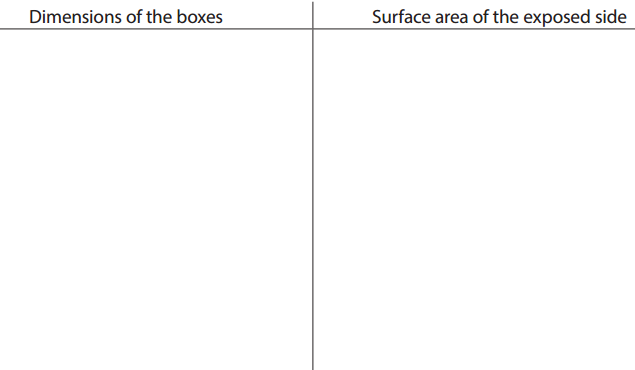
Answer:

Explanation:
As the students filled each box with an earthly material. They placed each box in the sun so that the side with the greatest surface area was most exposed to the sun. For each box, listed the surface area of the side that the students chose to expose in the table as shown above.
Question 3.
Predict what happened to the temperature when the students placed dry soil in each box. Explain your reasoning.
Answer:
In each box it is 78° F,
Explanation:
Predicted the temperature when the students placed dry soil in each box is 78° F.
Question 4.
Predict what happened when they placed water in each box. Explain your reasoning.
Answer:
In each box it is 75° F,
Explanation:
Predicted the temperature when the students placed water in each box is 75° F.
Bridges in Mathematics Grade 5 Student Book Unit 8 Module 2 Session 2 Answer Key
Earth Materials Questions
Use your Earth Materials Graph to help answer these questions.
Question 1.
Look at the graph. What do you notice about the data? Write at least two observations.
Answer:
Temperature of water in sun is 66 degrees Fahrenheit and in shade is 83 degrees Fahrenheit,
Temperature of rock in sun is 64 degrees Fahrenheit and in shade is 103 degreed Fahrenheit,
Explanation:
As we noticed that the Earth materials have different temperatures in sun and in shade so from that the two observations are noticed respectively.
Question 2.
Which material collected the most solar energy? How do you know?
Answer:
Rock material collected the most solar energy,
Explanation:
As due to the temperature stratification along the pile axis the major portion of the stored heat can be recovered at a temperature , this shows that the rock pile may be successfully used for solar energy storage .
Question 3.
Which material collected the least solar energy? How do you know?
Answer:
Water collected least solar energy,
Explanation:
As flowing of water on the solar panel reduces the temperature of the solar panels so, water collected least solar energy.
Question 4.
Which material lost the most heat? How do you know?
Answer:
Rocks lost most heat,
Explanation:
As due to high thermal inertia rocks feels cold to touch so they lost most heat.
Question 5.
Which material stored the heat the longest? How do you know?
Answer:
Rocks stored the heat the longest,
Explanation:
Heat is stored in rock pile by circulating heated air from the collectors directly through the rock bed. Rock pile has the characteristic of very good transfer between the air and rocks.
Question 6.
Describe at least two things you learned about collecting and storing solar energy in earth materials by conducting this experiment.
Answer:
The following are the two things that learned about collecting and storing energy in earth materials,
Explanation:
1. Solar energy is a renewable energy source and reduces carbon emissions,
2. Home with solar panels installed may improve home value.
Earth Materials Experiment
Mr. Ivy’s class conducted an experiment to test the collection and storage of solar energy in earth materials. They left the materials in the sun for 20 minutes, then moved them to the shade and took temperature readings every 3 minutes. The graph below shows their results.
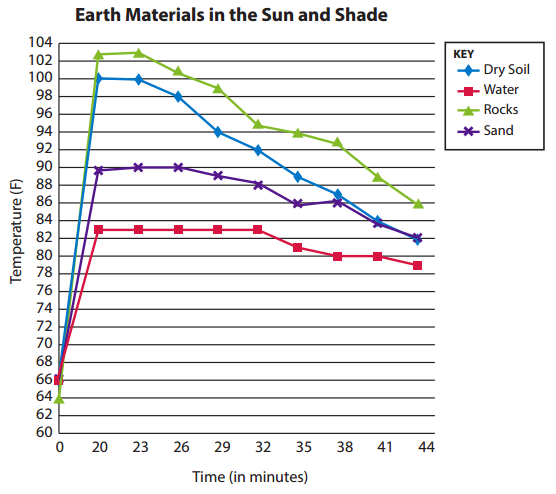
Question 1.
What was the temperature change in the shade for dry soil?
Answer:
82 degrees Fahrenheit,
Explanation:
From the above graph the temperature change in the shade for dry soil is 82 degrees Fahrenheit respectively.
Question 2.
Which material collected the least solar energy? How do you know?
Answer:
Water collected least solar energy,
Explanation:
As flowing of water on the solar panel reduces the temperature of the solar panels so, water collected least solar energy.
Question 3.
Which material lost the most heat? How do you know?
Answer:
Rocks lost most heat,
Explanation:
As due to high thermal inertia rocks feels cold to touch so they lost most heat.
Question 4.
How does sand compare to the other earth materials the class tested?
Answer:
Sand can be compared to the other materials as the class tested,
Explanation:
By testing the collection and storage of solar energy sand can be neither least nor high in temperature by comparing to the other earth materials respectively.
Bridges in Mathematics Grade 5 Student Book Unit 8 Module 2 Session 3 Answer Key
Window Orientation
Students in Mr. Ivy’s class wanted to conduct an experiment about the effect of the size and placement of windows on the amount of heat a house collected. They remembered reading that passive solar houses have large windows facing south to allow sunlight to enter in the winter and that awnings can protect the south facing windows from the sun when it is high in the sky in the summer. The class made model houses with different- size windows. They placed the large window on one house toward the sun. On another house, they placed the small window toward the sun. On a third house, they placed an awning over the large window and faced it toward the sun. On a fourth house, they added a solar water heater on the floor of the house, faced the large window toward the sun, and let the sun shine directly onto the solar water heater.

They left the houses in the sun for two hours and took temperature readings every half-hour. Then they removed all of the houses from the sun and continued to take temperature readings. The class then created a graph of their data:
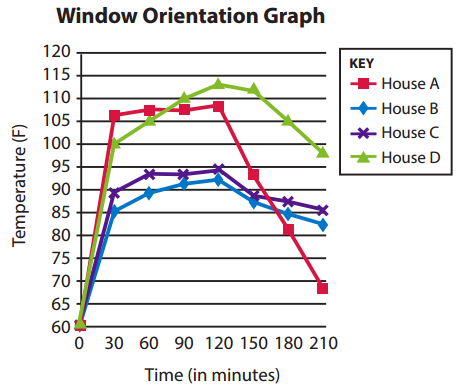
Question 1.
What do you notice about the data? List at least three observations.
Answer:
We noticed that effect of house and placement of windows on amount of the heat of a house is collected,
Explanation:
The temperature of the House A , House B , House C in the sun for two hours is 60 degrees Fahrenheit , and temperature removed from the sun of Houses A,B,C are 69 , 83 , 85 degrees Fahrenheit respectively.
Question 2.
Which house is best for the summer? Explain your reasoning.
Answer:
House B is best for the summer,
Explanation:
As House B is best because that awnings can protect the south facing windows from the sun when it is high in the sky in the summer.
Question 3.
Which house is best for the winter? Explain your reasoning.
Answer:
House A is best for the winter,
Explanation:
As house A is best for the winter because that passive solar houses have large windows facing south to allow sunlight to enter in the winter.
Making Windows
Solve each problem. Show your work using words, numbers, or labeled sketches.
Question 1.
Mr. Ivy’s class made model houses with the dimensions of 11” wide by 10” long by 8” tall. What is the volume of one of their model houses?
Answer:
Volume of model houses is 880 cubic inches,
Explanation:
Given from above dimensions of model houses are wide is 11 inches , length is 10 inches ,height is 8 inches therefore , volume of model house is V = W X L X H = 11 inches X 10 inches X 8 inches = 880 cubic inches respectively.
Question 2.
What is the combined surface area of the four walls?
Answer:
Surface area of four walls is 556 square inches,
Explanation:
As we know that surface area of cuboid is 2 X (LW + WH + LH) so, therefore 2 X [( 10 x 11 ) + (11 x 8 ) + ( 10 x 8 )] = 2 (110 sq. inches + 88 sq. inches + 80 sq. inches ) = 2(278 sq. inches ) = 556 sq. inches.
Question 3.
The students need to cut out windows that will take up of the surface area of the four walls. How many square inches of windows do they need to cut out?
Answer:
30 square inches,
Explanation:
As the students need to cut out windows that will take up of the surface area of the four walls. Square inches of windows do they need to cut out is wide is 6 inches , length is 5 inches 6 inches X 5 inches = 30 square inches.
Question 4.
Draw a sketch of each of the four walls with the windows cut out. Label the dimensions of each of the windows.
Answer:

Explanation:
Drawn a sketch of each of the four walls with the windows cut out. Labeled the dimensions of each of the windows above as 6 inches length and 5 inches wide.
Bridges in Mathematics Grade 5 Student Book Unit 8 Module 2 Session 4 Answer Key
Insulation Materials
Question 1.
Which insulator do you think will keep a cup of warm water warmest the longest? Explain your reasoning.
Answer:
Glass mug, cotton and plastic,
Explanation:
Bases on the thermal conductivity knowledge a glass mug should be used to keep liquids the warmest for the longest period respectively.
Question 2.
Follow these directions to test your prediction.
- Each team member choose a different insulation material to test. One person will be in charge of the control cup and will not use insulation material.
- Surround your cup with your insulation material.
- Fill your cup with \(\frac{1}{3}\) cup hot water.
- Place a thermometer in the cup and record the temperature.
- Seal the cup with plastic wrap and a rubber band.
- Place a thermometer in one uninsulated, uncovered cup to act as the control.
- Record the temperature of your cup every four minutes in the table that follows.
- Get the data from your other team members after each temperature reading and record it in the table, too.
- Stop recording temperatures after 16 minutes.

Answer:
88° F, 92° F, 94° F,
Explanation:
Following the directions to test my prediction, Each team member choose a different insulation material to test. One person will be in charge of the control cup and will not use insulation material. Surround my cup with my insulation material. Filled my cup with \(\frac{1}{3}\) cup hot water. Placed a thermometer in the cup and recorded the temperature as 88° F sealed the cup with plastic wrapped a rubber band. Placed a thermometer in one uninsulated, uncovered cup to act as the control. Recorded the temperature of my cup every four minutes got the data from my other team members after each temperature reading and recorded it too. Stopped recording temperatures after 16 minutes. Sealed the cup with plastic wrap and a rubber band. Placed a thermometer in one uninsulated, uncovered cup to act as the control. Recorded the temperature of my cup every four minutes. Got the data from your other team members after each temperature reading and record it too. Stopped recording temperatures after 16 minutes as 92° F, 94° F respectively.
Question 3.
Record your data in the table below. Enter the data for the other insulation materials next to your data.

Answer:
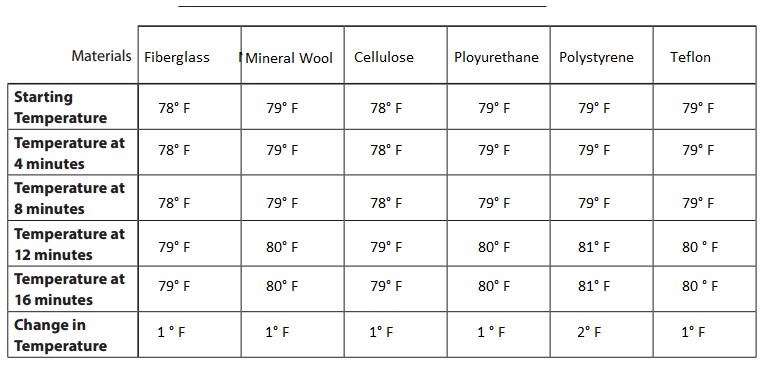
Explanation:
Recorded my data in the table above. Entered the data for the other insulation materials next to my data as shown above.
Question 4.
Plot the data your team collected on a graph. Give the graph a title and label each axis.

Answer:

Explanation:
Plotted the data of my team collected on the graph above. Gave the graph a title of Insulation materials & Temperature and labeled each axis as x -axis time and y -axis temperatures.
Question 5.
What do you notice about the data? Record at least two observations.
Answer:
The temperature when the other insulation materials are used has not been much difference only 1° F to 2° F,
Explanation:
When the other insulation materials are used there has not been much difference in the temperatures only 1° F or 2° F.
Question 6.
How does the temperature change over time?
Answer:
Only 1° F to 2° F,
Explanation:
The temperature change over time is 1° F to 2° F.
Question 7.
Which was the best insulator and which was the worst? How do you know?
Answer:
Best : Polystyrene,
Worst : Fiberglass, Mineral Wool, Cellulose , Polyurethane, Teflon
Explanation:
The best insulator is the material made of Polystyrene it is having good rate of temperature.
The worst insulator is the material made of Fiberglass, Mineral Wool, Cellulose , Polyurethane, & Teflon as it has less rate of temperature than Polystyrene.
Question 8.
CHALLENGE Using the same materials, how could you make an even better insulator?
Answer:
Using insulation materials run the gamut from bulky fiber materials such as fiberglass, rock and slag wool, cellulose, and natural fibers to rigid foam boards to sleek foils. Bulky materials resist conductive and to a lesser degree convective heat flow in a building cavity,
Explanation:
Insulation materials run the gamut from bulky fiber materials such as fiberglass, rock and slag wool, cellulose, and natural fibers to rigid foam boards to sleek foils. Bulky materials resist conductive and to a lesser degree convective heat flow in a building cavity. Rigid foam boards trap air or another gas to resist heat flow. Highly reflective foils in radiant barriers and reflective insulation systems reflect radiant heat away from living spaces, making them particularly useful in cooling climates. Other less common materials such as cementitious and phenolic foams and vermiculite and perlite are also available.
Amount of Insulation Materials
Question 1.
The students in Ms. Vega’s class wanted to test the insulating qualities of different materials using boxes instead of cups. They built boxes, open at the top, with walls that were 3” tall by 5\(\frac{1}{4}\)” wide.

a. What is the surface area of one of the four walls? Show your work.
Answer:
\(\frac{561}{2}\) or 280\(\frac{1}{2}\),
Explanation:
The surface area of one of the four walls is 2 X (LW + WH + LH) = 2 X (5\(\frac{1}{4}\) X 5\(\frac{1}{4}\) + 3 X 5\(\frac{1}{4}\) + 5\(\frac{1}{4}\) X 3) = 2 X (441/4 + 63/4 + 63/4) = 2 X (441+ 63 + 63)/4 = 561/2 = \(\frac{561}{2}\) or as numerator is greater we write in mixed fraction as 280\(\frac{1}{2}\).
b. What is the surface area of the bottom of the box? Show your work.
Answer:
\(\frac{561}{2}\) or 280\(\frac{1}{2}\),
Explanation:
As the surface area of the bottom of the box is 2 X (LW + WH + LH) = 2 X (5\(\frac{1}{4}\) X 5\(\frac{1}{4}\) + 3 X 5\(\frac{1}{4}\) + 5\(\frac{1}{4}\) X 3) = 2 X (441/4 + 63/4 + 63/4) = 2 X (441+ 63 + 63)/4 = 561/2 = \(\frac{561}{2}\) or as numerator is greater we write in mixed fraction as 280\(\frac{1}{2}\).
c. The floor and all four walls need to be insulated. What is the total surface area the class needs to cover with insulation materials? Show your work.
Answer:
\(\frac{561}{2}\) or 280\(\frac{1}{2}\),
Explanation:
As the floor and all four walls need to be insulated. The total surface area the class needs to cover with insulation materials of 2 X (LW + WH + LH) = 2 X (5\(\frac{1}{4}\) X 5\(\frac{1}{4}\) + 3 X 5\(\frac{1}{4}\) + 5\(\frac{1}{4}\) X 3) = 2 X (441/4 + 63/4 + 63/4) = 2 X (441+ 63 + 63)/4 = 561/2 = \(\frac{561}{2}\) or as numerator is greater we write in mixed fraction as 280\(\frac{1}{2}\).
Question 2.
The class has styrofoam that comes in sheets with the dimensions of 9.5″ × 9.5”. Is one sheet enough to cover one box? If it is, draw a sketch showing how. If it isn’t, explain why.
Answer:
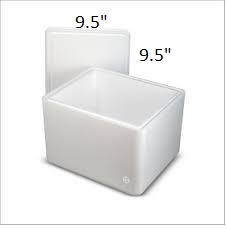
Yes,
Explanation:
As the class has styrofoam that comes in sheets with the dimensions of 9.5″ X 9.5”. Yes one sheet is enough to cover one box drawn a sketch showing it above.
Bridges in Mathematics Grade 5 Student Book Unit 8 Module 2 Session 5 Answer Key
Insulating Our House
Question 1.
Follow these requirements to insulate your house.
- You can insulate your door, but it must open and close.
- You may not cover your windows with anything but curtains or storm windows.
- Insulation on the floor and walls cannot exceed \(\frac{1}{2}\) inch in thickness. The ceiling cannot exceed 1 inch.
Answer:
Following these requirements to insulate my house, I have insulated my door but it is open and close. I may not cover my windows with anything but curtains or storm windows. Insulation on the floor and walls have not exceed \(\frac{1}{2}\) inch in thickness and the ceiling has not exceed 1 inch,
Question 2.
Examine the insulation materials available and their cost.
- You may not buy more than $4.00 of insulation materials.
- As a team, determine the type and amount of the materials you want to use.
- Use scratch paper to draw sketches to help you determine the amount of each material you need.
- Record the amount and cost of each insulation material on the cost sheet below.
- Calculate the total cost for all the materials and write it below the table.
- Check your calculations to make sure you have enough of every material you need.
- When you have completed the cost sheet, send a team member to buy the materials from your teacher.
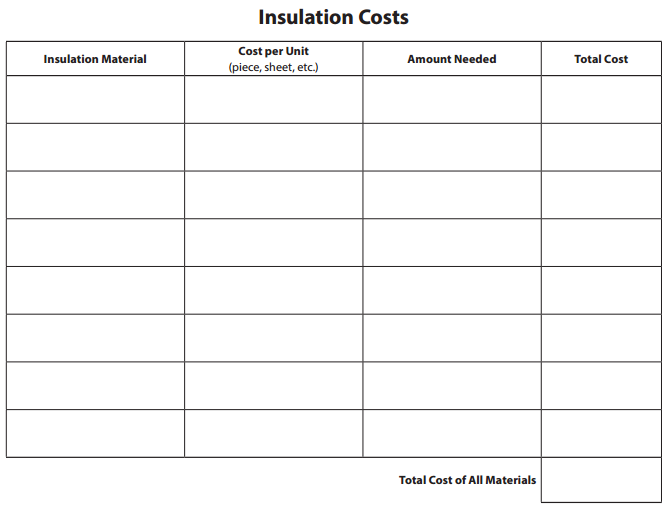
Answer:

Explanation:
Examined the insulation materials available and their cost not purchased more than $4.00 of insulation materials. As a team, determined the type and amount of the materials I want to use. Recorded the amount and cost of each insulation material on the cost sheet above. Calculated the total cost for all the materials and wrote it above the table. Checked my calculations to make sure that I have enough of every material I needed, When I have completed the cost sheet sent a team member to buy the materials from my teacher.
Buying Window Materials
The students in Mr. Ivy’s class plan to buy some insulation materials for their model houses. The costs are listed in the table below.
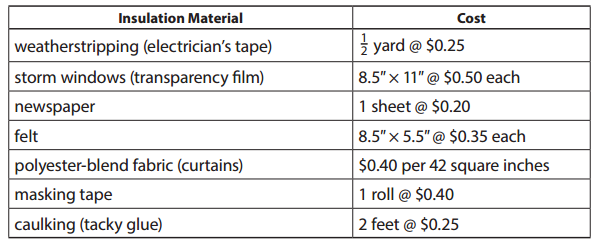 ‘
‘
Question 1.
Ramon’s team wants to use weather stripping. How many inches of weather stripping will one window of their house get if two windows share \(\frac{1}{2}\) yard equally? Show your work.
Answer:
9 inches of weather stripping will one window of their house get,
Explanation:
Given , Fraction of yard of two windows share equally is \(\frac{1}{2}\) so, as we know 18 inches is equal to 1/2 yard so , (1/2) x 18 = 9 inches .
Question 2.
Suki’s team’s house has 12 windows, each with a perimeter of 9 inches. How many yards of weather stripping do they need to buy? Show your work.
Answer:
54 yards,
Explanation:
Given from above perimeter of each window is 9 inches so, total perimeter of 12 windows is 12 X 9 =108 inches so from above table 108 x (1/2) = 54 yards.
Question 3.
Sarah’s team needs \(\frac{1}{3}\) foot of caulking per small window. Sarah says that 2 feet is enough for their 4 small windows. Is she correct? Why or why not?
Answer:
Yes Sarah is correct needed is \(\frac{4}{3}\) foot < 2 feet,
Explanation:
Given Sarah’s team needs \(\frac{1}{3}\) foot of caulking per small window. Sarah says that 2 feet is enough for their 4 small windows. Yes she correct as Sarah requires 4 X \(\frac{1}{3}\) = \(\frac{4}{3}\) as numerator is greater than denominator we get 1\(\frac{1}{3}\) which is less than 2 so she is true.
Question 4.
CHALLENGE Sarah’s team wants to make curtains for their windows. Their windows have 56 square inches of total surface area. How much do they need to spend on curtain material? How much material will be left? Use pictures, numbers, and words to show your answer.
Answer:
Material will be left is 8 square inches,
Explanation:
Given Sarah’s team wants to make curtains for their windows. Their windows have 56 square inches of total surface area. As Sarah team has \(\frac{1}{3}\) foot as 1 foot is equal to 12 inches and 4 windows so team needs 4 X \(\frac{1}{3}\) X 12 inches X 4 inches = 64 square inches so material left is 64 square inches – 56 square inches = 8 square inches.
Bridges in Mathematics Grade 5 Student Book Unit 8 Module 2 Session 6 Answer Key
Testing Our House
In this experiment, your team will fill the container with hot water and place it inside your insulated house. The container of hot water will act as a furnace to heat the house.
Question 1.
What do you think will happen to the temperature of your house when you add the hot water furnace and let it sit for two hours?
Answer:
The water heater rod becomes useless,
Explanation:
The rod becomes useless after a long time of use with the tank water heater . The rod is then destroyed by the corrosive particles that settle down as water is getting boiling the water is evaporated totally and plastic bucket melting , heater fusing and some fire getting set off.
Question 2.
Follow these directions to test your prediction.
- Cut a small hole in your roof just large enough to slide one of your thermometers through.
- Align the thermometer at the 0° F mark.
- Fill a container with two cups of hot water.
- Use your second thermometer to find the temperature of the water, and record it in the table on the next page.
- Remove the second thermometer from the container of water.
- Carefully place the container of water in the middle of your insulated house.
- Place the roof on top of your house.
- Record the temperature inside your house in the table on the next page.
- Measure and record the temperature inside your house every 15 minutes.
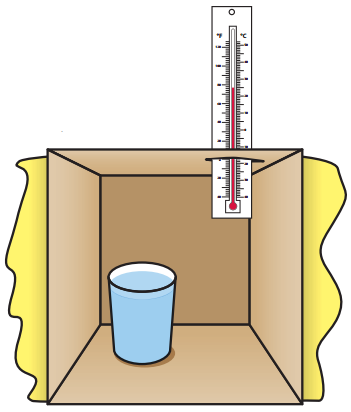
Answer:
Recorded the temperature inside my house every 15 minutes below,
Explanation:
Followed these directions to test my prediction cut a small hole in my roof just large enough to slide one of your thermometers through. Aligned the thermometer at the 0° F mark. Filled a container with two cups of hot water. Used my second thermometer to find the temperature of the water, and record it in the table below removed the second thermometer from the container of water. Carefully place the container of water in the middle of my insulated house. Placed the roof on top of my house. Recorded the temperature inside my house measured and recorded the temperature inside my house every 15 minutes below.
Question 3.
Record your data in the table below.
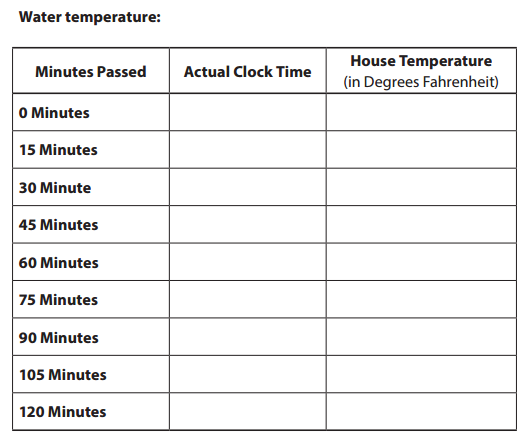
Answer:

Explanation:
Recorded my data in the table above.
Question 4.
Based on the data you’ve collected in the first 30 minutes, do you want to change your prediction? Explain your reasoning.
Answer:
No,
Explanation:
Based on the data I have collected in the first 30 minutes, No I don’t want to change my prediction there is not much difference so I will not change.
Insulation Experiment
Question 1.
Mr. Ivy’s class-tested the insulation efficiency of their model houses. The class data is in the table below.

Plot the data on the graph below. Give the graph a title and label the axes.
Answer:

Explanation:
plotted the graph of Insulation house experiment as given the data from above and labeled the axes respectively.
For the next three questions, explain your reasoning in your math journal.
Question 2.
Which team had the most efficient house?
Answer:
Team 3 is most efficient house,
Explanation:
As team 3 is capable of insulating most efficient model house without wasting time.
Question 3.
Which team had the least efficient house?
Answer:
Team 4 is least efficient house,
Explanation:
As team is least efficient because the insulation efficiency is low.
Question 4.
Predict what the temperature in each house was after 3 hours.
Answer:
After 3 hours the temperature in each house is Team 1 at 180 minutes in 64° F Team 2 – 75° F, Team 3 – 70° F, Team 4 – 69° F,
Explanation:
Predicting the temperature in the each house after 3 hours is as Team 1 is reducing 2° F starting from 66° F so after 180 minutes it will be 72° F – 8° F = 64° F, Team 2 is reducing approximately 1° F starting from 66° F so after 180 minutes it will be 79° F – 4° F = 75° F,
Team 3 is reducing 2° F starting from 66° F so after 180 minutes it will be 78° F – 8° F = 70° F,
Team 4 is reducing 1° F starting from 66° F so after 180 minutes it will be 73° F – 4° F = 64° F respectively.